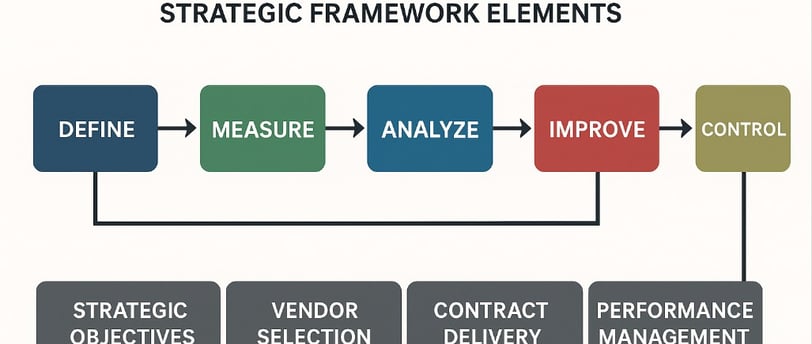Revolutionizing IT Sourcing Through Six Sigma: A Strategic Framework for Operational Excellence
The convergence of Six Sigma methodology with IT sourcing represents one of the most transformative approaches to procurement optimization in the digital age. As organizations increasingly rely on technology infrastructure and services, the need for systematic, data-driven improvement in IT sourcing processes has never been more critical. Six Sigma provides a proven framework that enables organizations to achieve exceptional results in cost reduction, quality improvement, and operational efficiency across their technology procurement operations.
Roydon Barnham
6/19/20256 min read


Understanding Six Sigma: The Foundation for IT Sourcing Excellence
Six Sigma is a data-driven methodology that provides organizations with the tools to improve business process capabilities by reducing variation and eliminating defects. Originally developed by Motorola in the 1980s, Six Sigma has evolved into a comprehensive quality management approach that views all work as processes that can be defined, measured, analyzed, improved, and controlled. The methodology's goal of achieving 3.4 defects per million opportunities translates directly to IT sourcing environments where precision, consistency, and reliability are paramount.
The Six Sigma approach operates on two primary methodologies: DMAIC (Define, Measure, Analyze, Improve, Control) for improving existing processes, and DMADV (Define, Measure, Analyze, Design, Verify) for creating new processes. In IT sourcing contexts, DMAIC proves particularly valuable as most organizations seek to optimize existing procurement workflows rather than design entirely new systems.
Critical Challenges in IT Sourcing That Six Sigma Addresses
IT sourcing presents unique complexities that traditional procurement approaches often struggle to manage effectively. Organizations face mounting challenges including chip shortages causing lead time delays, greater logistics and staffing barriers, and fluctuating prices due to high demand. These issues are compounded by the rapid pace of technological change, making it difficult for procurement specialists to choose surviving standards and maintain competitive advantage.
Common IT sourcing challenges include unclear expectations that hinder growth and scope expansion, difficulty in mapping and analyzing current IT spend patterns with limited visibility, and the complexity of working with cross-functional project teams across different departments. Additionally, organizations struggle with fragmented coordination among buyers, program management, and IT staff, resulting in either vague or overly prescriptive RFPs.
The financial impact of these challenges is substantial, with IT representing one of the biggest expense items on organizational financial statements. Poor IT procurement decisions can result in cost overruns, extended implementation timelines, and systems that fail to meet business requirements.
The DMAIC Framework: Systematic Approach to IT Sourcing Improvement
The DMAIC methodology provides a structured, five-phase approach that transforms IT sourcing from reactive to proactive strategic function. Each phase builds upon previous insights to create sustainable improvements in procurement outcomes.
Define Phase: Establishing Clear IT Sourcing Objectives
The Define phase focuses on identifying specific IT sourcing problems and establishing clear, measurable objectives. This involves detailed stakeholder analysis to understand internal customer requirements, technology specifications, and business alignment needs. Organizations must define critical-to-quality (CTQ) characteristics that determine procurement success, such as total cost of ownership, implementation timelines, and technical performance standards.
Measure Phase: Data-Driven Baseline Establishment
The Measure phase involves collecting comprehensive data on current IT sourcing performance to establish baseline measurements. This includes tracking key metrics such as procurement cycle times, supplier performance ratings, contract compliance levels, and cost variances. Organizations implementing Six Sigma in procurement typically measure defect rates in purchase orders, invoice processing accuracy, and supplier delivery performance.
Analyze Phase: Root Cause Investigation
The Analyze phase utilizes statistical tools and techniques to identify root causes of IT sourcing inefficiencies. This involves process mapping to visualize current workflows, cause-and-effect analysis to understand problem relationships, and data analysis to validate hypotheses about performance gaps. Advanced analytics can reveal patterns in supplier performance, identify bottlenecks in approval processes, and highlight areas where procurement policies may be hindering efficiency.
Improve Phase: Solution Implementation and Testing
The Improve phase focuses on developing and implementing solutions based on analytical insights. This includes piloting new procurement processes, implementing technology solutions, and redesigning supplier evaluation criteria. Organizations often test changes on small scales before full implementation to validate effectiveness and minimize risk.
Control Phase: Sustainable Performance Management
The Control phase ensures that improvements are maintained over time through monitoring systems and process controls. This involves establishing key performance indicators (KPIs), implementing regular review cycles, and creating feedback mechanisms to detect and correct deviations from improved performance standards.
Quantifiable Benefits: The ROI of Six Sigma in IT Sourcing
Organizations implementing Six Sigma in IT sourcing consistently achieve remarkable financial and operational improvements. Research indicates that Six Sigma projects deliver an average return of $230,000 per project with ROI ratios ranging from 4.5 to 6 times the training investment. In procurement contexts, organizations typically achieve 15-30% cost reductions while improving process efficiency by 25-40%.
The financial benefits extend beyond direct cost savings to include improved supplier performance, reduced cycle times, and enhanced quality outcomes. Organizations report significant improvements in transaction quality, with first-pass invoice rates increasing substantially through enhanced purchase order and receipt details. Electronic orders and deliveries benefit from Six Sigma methodologies that minimize errors and optimize electronic system utilization.
Cycle time reduction represents another major benefit area, with organizations achieving 20-46% reductions in procurement processing times. These improvements directly impact budget performance and manager commitment to procurement projects, as lengthy cycles often erode stakeholder engagement and project momentum.
Technology Integration: AI and Digital Transformation in Six Sigma
The integration of artificial intelligence and machine learning with Six Sigma methodologies is revolutionizing IT sourcing capabilities. AI-powered analytics enable real-time competitive monitoring, predictive modeling of supplier performance, and automated root cause analysis. This technological evolution allows organizations to achieve improvement gains of 40-60% or more, significantly exceeding traditional Six Sigma standards of 3% annual improvement.
Modern Six Sigma implementations leverage digital tools including up-to-the-minute data analysis for process tracking, cloud-based collaboration platforms, and IoT devices for real-time monitoring. These technologies enable procurement teams to process vast amounts of data quickly, identify hidden problems, and complete improvement projects faster and at lower costs than traditional manual approaches.
The synergy between AI and Six Sigma works because both methodologies rely on data-driven decision-making and continuous enhancement. As organizations increasingly depend on AI's ability to interpret large volumes of data, alignment with Six Sigma principles becomes more natural and effective.
Industry Applications and Success Stories
Six Sigma has demonstrated exceptional value across diverse industry sectors in IT sourcing applications. In manufacturing environments, companies have achieved 45% reductions in production defects and 30% increases in throughput through systematic application of Six Sigma principles to technology procurement. These improvements result from better vendor selection, improved contract terms, and enhanced quality control processes.
Healthcare organizations utilize Six Sigma to optimize their IT procurement for patient care systems and operational infrastructure. Mayo Clinic's implementation of data-driven procurement processes resulted in 35% reductions in equipment acquisition timelines and 28% improvements in system integration success rates.
Financial services organizations leverage Six Sigma for technology risk management and operational efficiency. JPMorgan Chase implemented advanced analytics in their technology procurement processes, achieving 35% improvements in vendor evaluation accuracy while reducing procurement-related risks by 45%.
Implementation Strategy and Best Practices
Successful Six Sigma implementation in IT sourcing requires careful planning, stakeholder engagement, and systematic execution. Organizations should begin with clearly defined project scopes that address specific procurement challenges and provide measurable business value. The process must involve cross-functional teams including procurement specialists, IT professionals, finance representatives, and business stakeholders.
Training and certification represent critical success factors, with organizations typically investing in Green Belt and Black Belt certification programs for key procurement team members. These certified professionals provide the technical expertise needed to execute statistical analysis, lead improvement projects, and sustain long-term results.
Technology infrastructure plays an essential role in modern Six Sigma implementations. Organizations should invest in procurement analytics platforms, supplier performance monitoring systems, and automated data collection tools that support continuous measurement and improvement.
Future Outlook: Evolution of Six Sigma in IT Sourcing
The future of Six Sigma in IT sourcing will be shaped by continued digital transformation, artificial intelligence integration, and evolving business requirements. Emerging trends include the use of predictive analytics for proactive supplier management, blockchain technology for contract transparency, and IoT devices for real-time performance monitoring.
Organizations are increasingly recognizing that procurement represents a strategic competitive advantage rather than simply a cost center. This perspective shift drives greater investment in Six Sigma capabilities and advanced analytics that enable procurement teams to contribute directly to business growth and innovation.
The integration of sustainability and ESG considerations into procurement processes represents another significant trend. Six Sigma methodologies provide the structured approach needed to measure, analyze, and improve environmental and social performance across supplier networks while maintaining cost and quality objectives.
Strategic Recommendations for IT Sourcing Excellence
Organizations seeking to leverage Six Sigma for IT sourcing transformation should focus on several key strategic initiatives. First, establish clear governance structures that align procurement objectives with broader business strategies and ensure adequate resource allocation for improvement initiatives. This includes defining roles and responsibilities, establishing performance metrics, and creating accountability mechanisms for sustained results.
Second, invest in comprehensive training and capability development that builds Six Sigma expertise throughout the procurement organization. This involves not only technical training in statistical methods and process improvement tools but also change management skills that enable teams to drive organizational transformation.
Third, implement technology infrastructure that supports data-driven decision making and continuous improvement. Modern procurement organizations require integrated platforms that provide real-time visibility into supplier performance, contract compliance, and market conditions.
Conclusion: Transforming IT Sourcing Through Six Sigma Excellence
Six Sigma represents a proven methodology for transforming IT sourcing from a transactional function into a strategic capability that drives business value and competitive advantage. The structured DMAIC approach provides organizations with the tools and framework needed to systematically identify, analyze, and eliminate inefficiencies while building sustainable improvement capabilities.
The quantifiable benefits of Six Sigma implementation in IT sourcing are substantial, with organizations consistently achieving significant cost reductions, cycle time improvements, and quality enhancements. As technology continues to evolve and procurement complexity increases, Six Sigma provides the disciplined approach needed to navigate challenges while capitalizing on emerging opportunities.
The future success of IT sourcing organizations will depend on their ability to combine traditional Six Sigma principles with modern digital technologies and data analytics capabilities. Organizations that master this integration will establish sustainable competitive advantages through superior procurement performance, enhanced supplier relationships, and improved business outcomes.
The time to invest in Six Sigma capabilities is now, before competitive pressures and technological disruption make transformation more difficult and expensive. Organizations that act decisively to build Six Sigma competencies in IT sourcing will position themselves for sustained success in an increasingly complex and competitive business environment.
Consulting
Expert guidance for sourcing and vendor management.
Strategy
Management
© 2025. All rights reserved.


